A Computational Fluid Dynamics Study of Laminar Forced Convection Improvement of a Non-Newtonian Hybrid Nanofluid within an Annular Pipe in Porous Media
Abstract
:1. Introduction
2. Problem Description
2.1. Configuration
2.2. Theoretical Formulation
2.3. Thermophysical Properties of the Nanofluid
2.4. Thermophysical Characteristics of the Hybrid Nanofluid
2.5. Boundary Conditions
2.6. Numerical Solution
2.7. Mesh Independence Analysis
2.8. Model Validation
3. Results and Discussions
3.1. The Influences of Volume Fraction on Heat Transfer
3.2. The Impacts of the Darcy Number on the Pressure Drop
3.3. The Impacts of Volume Fraction on the Performance Number
4. Temperature Contours
5. Conclusions
- By reducing the Darcy number (from to ) and increasing the thickness ratio of the porosity, the total Nusselt number rises.
- The heat transfer coefficient and total Nusselt number could be enhanced by incorporating metal nanoparticles into the CMC base fluid. Based on the results, at a constant porous thickness ratio and Darcy number as well as at a volume fraction of , the maximum total Nusselt number reached 1274.44 for both cases I and II. Moreover, increasing the volume fraction to an optimal value of 5%, considering and leads to an improvement in the total Nusselt number of approximately 14% for both cases I and II, in comparison to that with no usage of nanoparticles.
- Increasing the Darcy number lowers the pressure drop at a constant volume fraction.
- The pressure drop increased under the constant Darcy number by rising the porous thickness ratio.
- For the two cases I and II, which refer to the porous insert being situated in the inner and outer wall, respectively, the total Nusselt number and PN revealed an increasing pattern by augmenting the nanoparticles’ volume fraction from 0% to 5% in comparison to the CMC base fluid due to its thermophysical properties.
- Augmenting the Darcy number could enhance the PN. Additionally, regarding permeable porous media ( and , a maximum value for the PN can be obtained (. Furthermore, based on the outcomes for both cases I and II, by increasing the volume fraction of the nanoparticles to 5% at and , an augmented PN can be realized of around 88% compared to the zero volume fraction.
Author Contributions
Funding
Data Availability Statement
Conflicts of Interest
Nomenclature
| Specific heat/ | |
| Pipe diameter/ | |
| Gravity acceleration/ | |
| Porous medium permeability/ | |
| Thermal conductivity/ | |
| Length/m | |
| Consistency index | |
| Power-law index | |
| Nondimensional pressure | |
| Pressure/ | |
| Heat flux/ | |
| Pipe radius/m | |
| Porous substrate thickness/m | |
| Porous thickness ratio | |
| Temperature/ | |
| Velocity component/ | |
| Dimensional coordinates/m | |
| Greek symbols | |
| Shear rate/ | |
| Porosity | |
| Dynamic viscosity/ | |
| Density/ | |
| Volume fraction | |
| Subscripts | |
| Base | |
| Base fluid | |
| Effective | |
| Fluid | |
| Inner | |
| in | Inlet |
| hnf | Hybrid nanofluid |
| m | Mixture |
| Nanofluid | |
| Nanoparticles | |
| Outer | |
| p | Porous |
| Abbreviations | |
| 2D | Two-dimensional |
| CFD | Computational fluid dynamics |
| CMC | Carboxy methyl cellulose |
| Darcy number | |
| FVM | Finite volume method |
| Nusselt number | |
| PN | Performance number |
| Reynolds number | |
| SIMPLE | Semi-implicit method for pressure-linked equations |
References
- Ahmadi, A.A.; Khodabandeh, E.; Moghadasi, H.; Malekian, N.; Akbari, O.A.; Bahiraei, M. Numerical study of flow and heat transfer of water-Al2O3 nanofluid inside a channel with an inner cylinder using Eulerian–Lagrangian approach. J. Therm. Anal. Calorim. 2018, 132, 651–665. [Google Scholar] [CrossRef]
- Farhangmehr, V.; Moghadasi, H.; Asiaei, S. A nanofluid MHD flow with heat and mass transfers over a sheet by nonlinear boundary conditions: Heat and mass transfers enhancement. J. Cent. South Univ. 2019, 26, 1205–1217. [Google Scholar] [CrossRef]
- Mousavi Ajarostaghi, S.S.; Zaboli, M.; Javadi, H.; Badenes, B.; Urchueguia, J.F. A review of recent passive heat transfer enhancement methods. Energies 2022, 15, 986. [Google Scholar] [CrossRef]
- Malekian, S.; Fathi, E.; Malekian, N.; Moghadasi, H.; Moghimi, M. Analytical and numerical investigations of unsteady graphene oxide nanofluid flow between two parallel plates. Int. J. Thermophys. 2018, 39, 100. [Google Scholar] [CrossRef]
- Ghanbari, K.; Golneshan, A.A.; Yazdani, M.; Moghadasi, H.; Malekian, N. An experimental study of forced convective heat transfer for fully developed Al2O3–water nanofluid in an annulus tube. Heat Transf. 2021, 50, 5697–5713. [Google Scholar] [CrossRef]
- Cieśliński, J.T. Numerical Modelling of Forced Convection of Nanofluids in Smooth, Round Tubes: A Review. Energies 2022, 15, 7586. [Google Scholar] [CrossRef]
- Yang, L.; Ji, W.; Mao, M.; Huang, J.-n. An updated review on the properties, fabrication and application of hybrid-nanofluids along with their environmental effects. J. Clean. Prod. 2020, 257, 120408. [Google Scholar] [CrossRef]
- Moghadasi, H.; Aminian, E.; Saffari, H.; Mahjoorghani, M.; Emamifar, A. Numerical analysis on laminar forced convection improvement of hybrid nanofluid within a U-bend pipe in porous media. Int. J. Mech. Sci. 2020, 179, 105659. [Google Scholar] [CrossRef]
- Saghir, M.; Rahman, M. Forced convection of Al2O3–Cu, TiO2–SiO2, FWCNT–Fe3O4, and ND–Fe3O4 hybrid nanofluid in porous media. Energies 2020, 13, 2902. [Google Scholar] [CrossRef]
- Gowda, R.P.; Kumar, R.N.; Aldalbahi, A.; Issakhov, A.; Prasannakumara, B.; Rahimi-Gorji, M.; Rahaman, M. Thermophoretic particle deposition in time-dependent flow of hybrid nanofluid over rotating and vertically upward/downward moving disk. Surf. Interfaces 2021, 22, 100864. [Google Scholar] [CrossRef]
- Li, Y.-X.; Khan, M.I.; Gowda, R.P.; Ali, A.; Farooq, S.; Chu, Y.-M.; Khan, S.U. Dynamics of aluminum oxide and copper hybrid nanofluid in nonlinear mixed Marangoni convective flow with entropy generation: Applications to renewable energy. Chin. J. Phys. 2021, 73, 275–287. [Google Scholar] [CrossRef]
- Tahir, S.; Mital, M. Numerical investigation of laminar nanofluid developing flow and heat transfer in a circular channel. Appl. Therm. Eng. 2012, 39, 8–14. [Google Scholar] [CrossRef]
- Moshizi, S.; Malvandi, A.; Ganji, D.; Pop, I. A two-phase theoretical study of Al2O3–water nanofluid flow inside a concentric pipe with heat generation/absorption. Int. J. Therm. Sci. 2014, 84, 347–357. [Google Scholar] [CrossRef]
- Suresh, S.; Venkitaraj, K.; Selvakumar, P.; Chandrasekar, M. Synthesis of Al2O3–Cu/water hybrid nanofluids using two step method and its thermo physical properties. Colloids Surf. A Physicochem. Eng. Asp. 2011, 388, 41–48. [Google Scholar] [CrossRef]
- Moghadassi, A.; Ghomi, E.; Parvizian, F. A numerical study of water based Al2O3 and Al2O3–Cu hybrid nanofluid effect on forced convective heat transfer. Int. J. Therm. Sci. 2015, 92, 50–57. [Google Scholar] [CrossRef]
- Emamifar, A.; Moghadasi, H.; Noroozi, M.J.; Saffari, H. Transient analysis of convective-radiative heat transfer through porous fins with temperature-dependent thermal conductivity and internal heat generation. J. Therm. Eng. 2021, 8, 656–666. [Google Scholar] [CrossRef]
- Habibishandiz, M.; Saghir, M. A critical review of heat transfer enhancement methods in the presence of porous media, nanofluids, and microorganisms. Therm. Sci. Eng. Prog. 2022, 30, 101267. [Google Scholar] [CrossRef]
- Uphill, S.J.; Cosgrove, T.; Briscoe, W.H. Flow of nanofluids through porous media: Preserving timber with colloid science. Colloids Surf. A Physicochem. Eng. Asp. 2014, 460, 38–50. [Google Scholar] [CrossRef]
- Sundar, L.S.; Singh, M.K.; Sousa, A.C. Enhanced heat transfer and friction factor of MWCNT–Fe3O4/water hybrid nanofluids. Int. Commun. Heat Mass Transf. 2014, 52, 73–83. [Google Scholar] [CrossRef]
- Esfe, M.H.; Wongwises, S.; Naderi, A.; Asadi, A.; Safaei, M.R.; Rostamian, H.; Dahari, M.; Karimipour, A. Thermal conductivity of Cu/TiO2–water/EG hybrid nanofluid: Experimental data and modeling using artificial neural network and correlation. Int. Commun. Heat Mass Transf. 2015, 66, 100–104. [Google Scholar] [CrossRef]
- Targui, N.; Kahalerras, H. Analysis of a double pipe heat exchanger performance by use of porous baffles and nanofluids. Int. J. Mech. Aerosp. Ind. Mechatron. Manuf. Eng. 2014, 8, 1581–1586. [Google Scholar]
- Ajeeb, W.; Oliveira, M.S.; Martins, N.; Murshed, S.S. Performance evaluation of convective heat transfer and laminar flow of non-Newtonian MWCNTs in a circular tube. Therm. Sci. Eng. Prog. 2021, 25, 101029. [Google Scholar] [CrossRef]
- Naveen Kumar, R.; Gowda, R.; Gireesha, B.; Prasannakumara, B. Non-Newtonian hybrid nanofluid flow over vertically upward/downward moving rotating disk in a Darcy–Forchheimer porous medium. Eur. Phys. J. Spec. Top. 2021, 230, 1227–1237. [Google Scholar] [CrossRef]
- Sarada, K.; Gowda, R.J.P.; Sarris, I.E.; Kumar, R.N.; Prasannakumara, B.C. Effect of magnetohydrodynamics on heat transfer behaviour of a non-Newtonian fluid flow over a stretching sheet under local thermal non-equilibrium condition. Fluids 2021, 6, 264. [Google Scholar] [CrossRef]
- Yang, L.; Du, K. A comprehensive review on the natural, forced, and mixed convection of non-Newtonian fluids (nanofluids) inside different cavities. J. Therm. Anal. Calorim. 2020, 140, 2033–2054. [Google Scholar] [CrossRef]
- Hatami, M.; Ganji, D. Heat transfer and flow analysis for SA-TiO2 non-Newtonian nanofluid passing through the porous media between two coaxial cylinders. J. Mol. Liq. 2013, 188, 155–161. [Google Scholar] [CrossRef]
- Shahsavar, A.; Godini, A.; Sardari, P.T.; Toghraie, D.; Salehipour, H. Impact of variable fluid properties on forced convection of Fe3O4/CNT/water hybrid nanofluid in a double-pipe mini-channel heat exchanger. J. Therm. Anal. Calorim. 2019, 137, 1031–1043. [Google Scholar] [CrossRef]
- Moraveji, M.K.; Haddad, S.M.H.; Darabi, M. Modeling of forced convective heat transfer of a non-Newtonian nanofluid in the horizontal tube under constant heat flux with computational fluid dynamics. Int. Commun. Heat Mass Transf. 2012, 39, 995–999. [Google Scholar] [CrossRef]
- Miansari, M.; Aghajani, H.; Zarringhalam, M.; Toghraie, D. Numerical study on the effects of geometrical parameters and Reynolds number on the heat transfer behavior of carboxy-methyl cellulose/CuO non-Newtonian nanofluid inside a rectangular microchannel. J. Therm. Anal. Calorim. 2021, 144, 179–187. [Google Scholar] [CrossRef]
- Aminian, E.; Moghadasi, H.; Saffari, H.; Gheitaghy, A.M. Investigation of forced convection enhancement and entropy generation of nanofluid flow through a corrugated minichannel filled with a porous media. Entropy 2020, 22, 1008. [Google Scholar] [CrossRef]
- Al-Rashed, A.A.; Shahsavar, A.; Entezari, S.; Moghimi, M.; Adio, S.A.; Nguyen, T.K. Numerical investigation of non-Newtonian water-CMC/CuO nanofluid flow in an offset strip-fin microchannel heat sink: Thermal performance and thermodynamic considerations. Appl. Therm. Eng. 2019, 155, 247–258. [Google Scholar] [CrossRef]
- Zainith, P.; Mishra, N.K. Experimental investigations on stability and viscosity of carboxymethyl cellulose (CMC)-based non-newtonian nanofluids with different nanoparticles with the combination of distilled water. Int. J. Thermophys. 2021, 42, 137. [Google Scholar] [CrossRef]
- Aminian, E.; Moghadasi, H.; Saffari, H. Magnetic field effects on forced convection flow of a hybrid nanofluid in a cylinder filled with porous media: A numerical study. J. Therm. Anal. Calorim. 2020, 141, 2019–2031. [Google Scholar] [CrossRef]
- Ashorynejad, H.R.; Shahriari, A. MHD natural convection of hybrid nanofluid in an open wavy cavity. Results Phys. 2018, 9, 440–455. [Google Scholar] [CrossRef]
- Pordanjani, A.H.; Vahedi, S.M.; Aghakhani, S.; Afrand, M.; Öztop, H.F.; Abu-Hamdeh, N. Effect of magnetic field on mixed convection and entropy generation of hybrid nanofluid in an inclined enclosure: Sensitivity analysis and optimization. Eur. Phys. J. Plus 2019, 134, 412. [Google Scholar] [CrossRef]
- Ramachandran, R.; Ganesan, K.; Rajkumar, M.; Asirvatham, L.; Wongwises, S. Comparative study of the effect of hybrid nanoparticle on the thermal performance of cylindrical screen mesh heat pipe. Int. Commun. Heat Mass Transf. 2016, 76, 294–300. [Google Scholar] [CrossRef]
- Tahat, M.S.; Benim, A.C. Experimental analysis on thermophysical properties of Al2O3/CuO hybrid nano fluid with its effects on flat plate solar collector. Defect Diffus. Forum 2017, 76, 148–156. [Google Scholar] [CrossRef]
- Saqib, M.; Khan, I.; Shafie, S. Natural convection channel flow of CMC-based CNTs nanofluid. Eur. Phys. J. Plus 2018, 133, 549. [Google Scholar] [CrossRef]
- Akbari, O.A.; Toghraie, D.; Karimipour, A.; Marzban, A.; Ahmadi, G.R. The effect of velocity and dimension of solid nanoparticles on heat transfer in non-Newtonian nanofluid. Phys. E Low-Dimens. Syst. Nanostruct. 2017, 86, 68–75. [Google Scholar] [CrossRef]
- Siavashi, M.; Bahrami, H.R.T.; Saffari, H. Numerical investigation of flow characteristics, heat transfer and entropy generation of nanofluid flow inside an annular pipe partially or completely filled with porous media using two-phase mixture model. Energy 2015, 93, 2451–2466. [Google Scholar] [CrossRef]


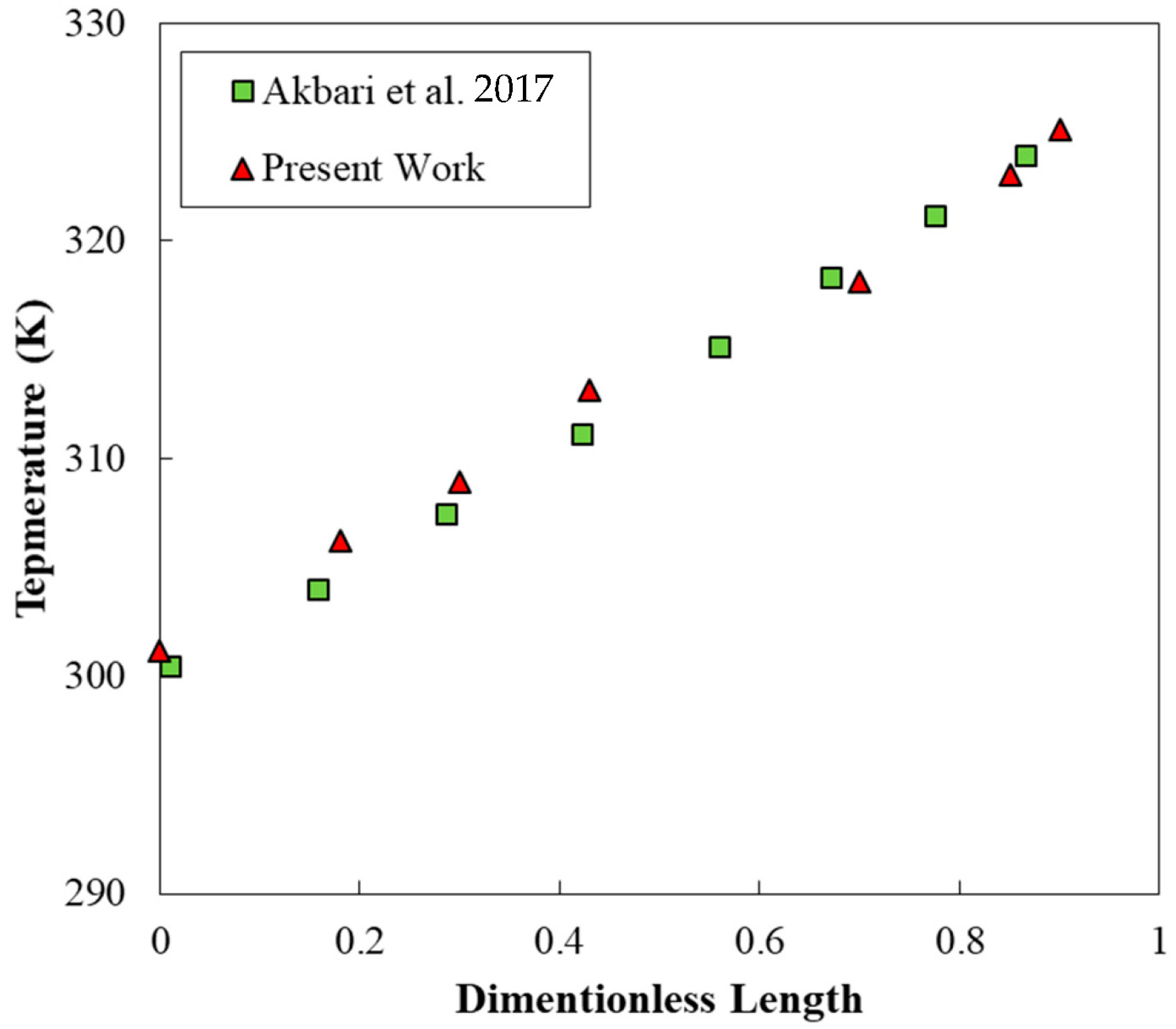
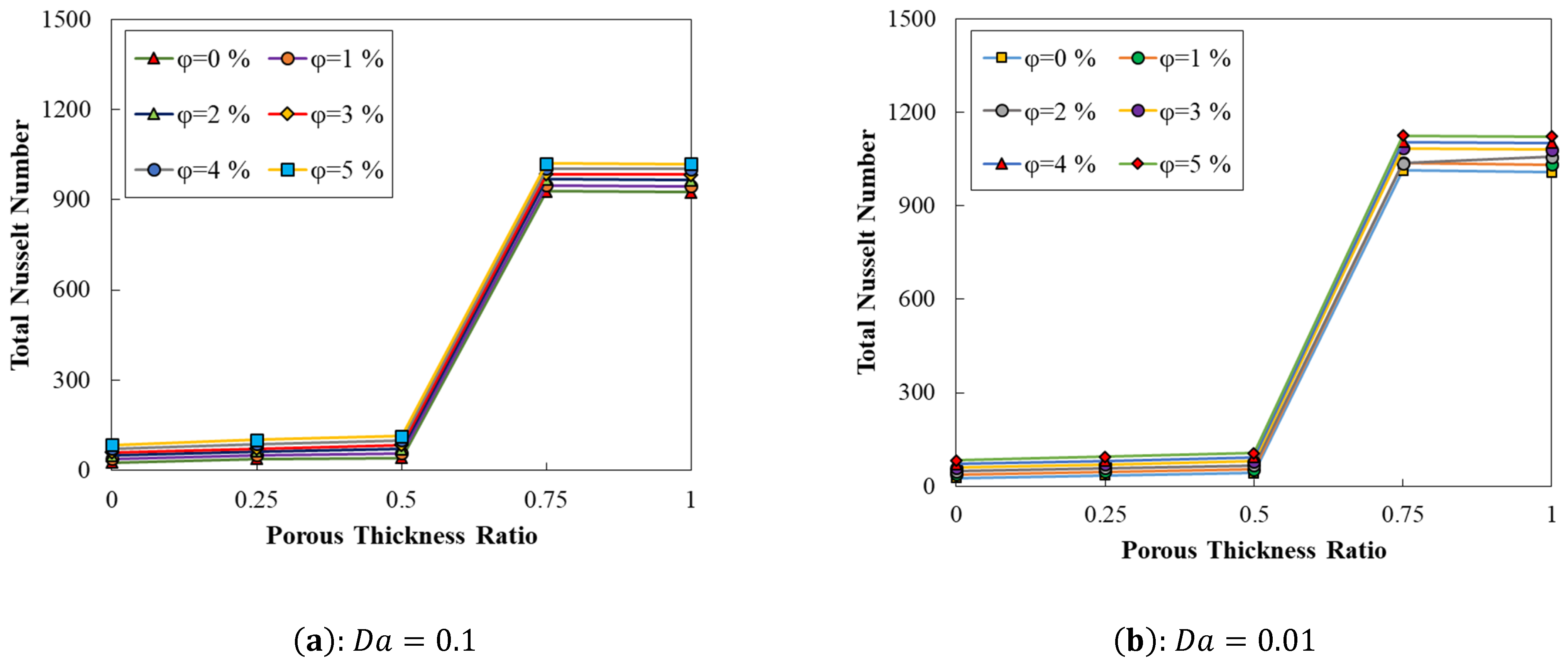

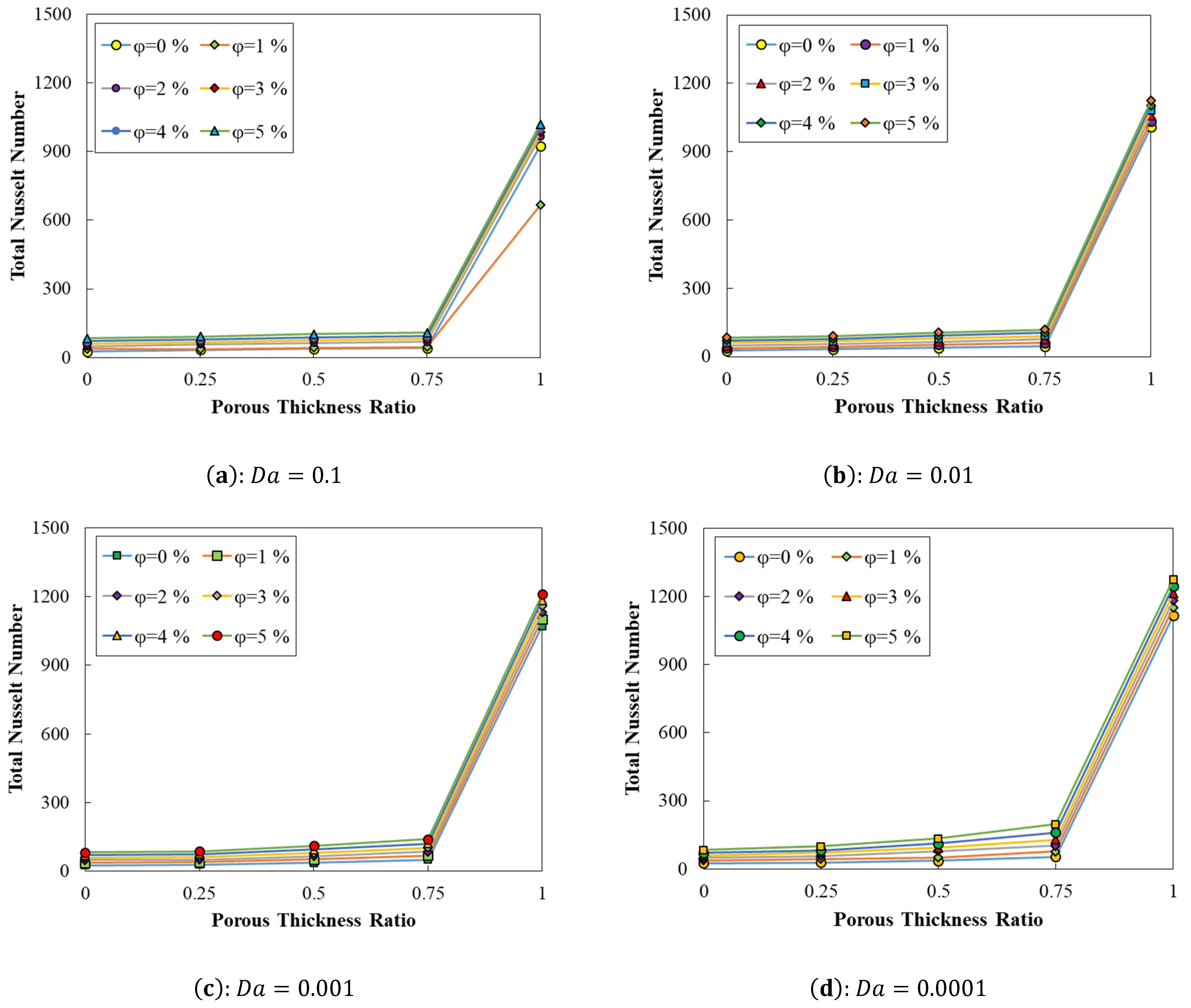
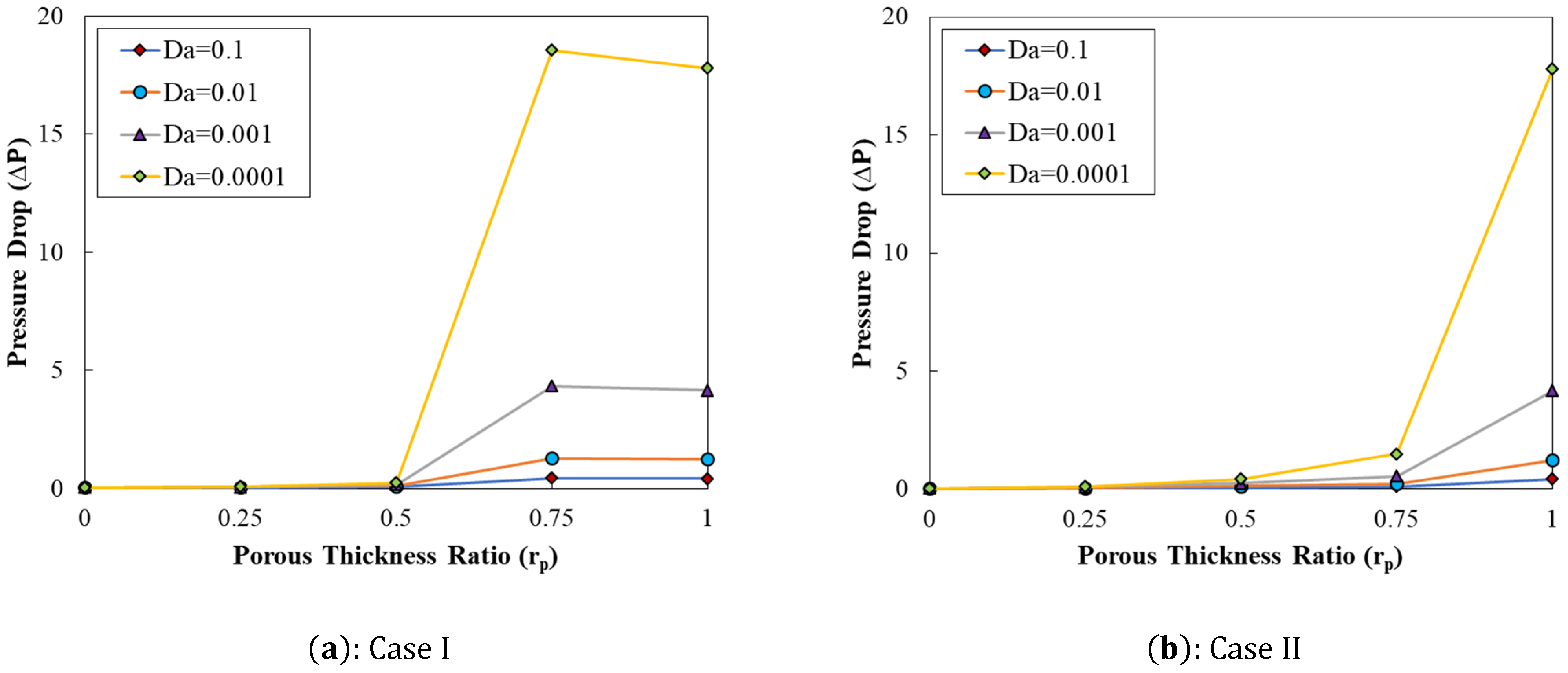
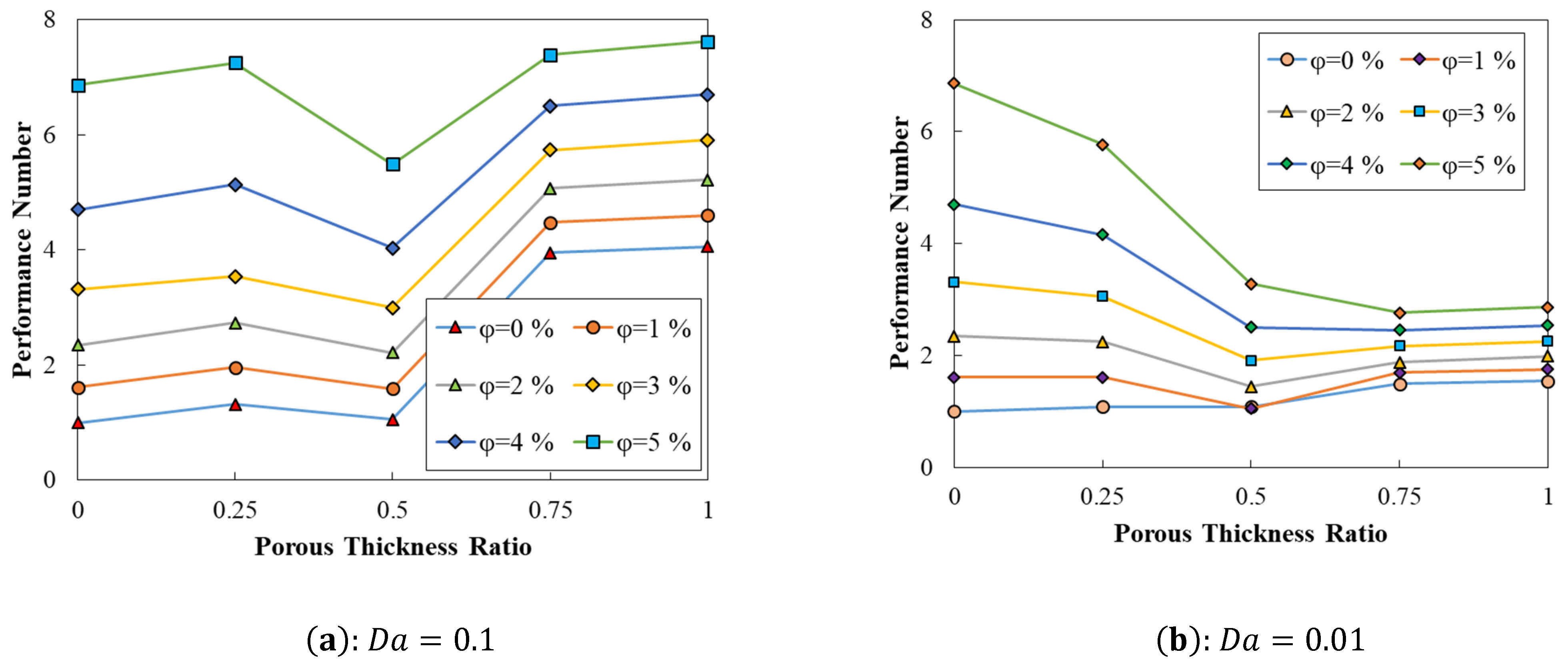
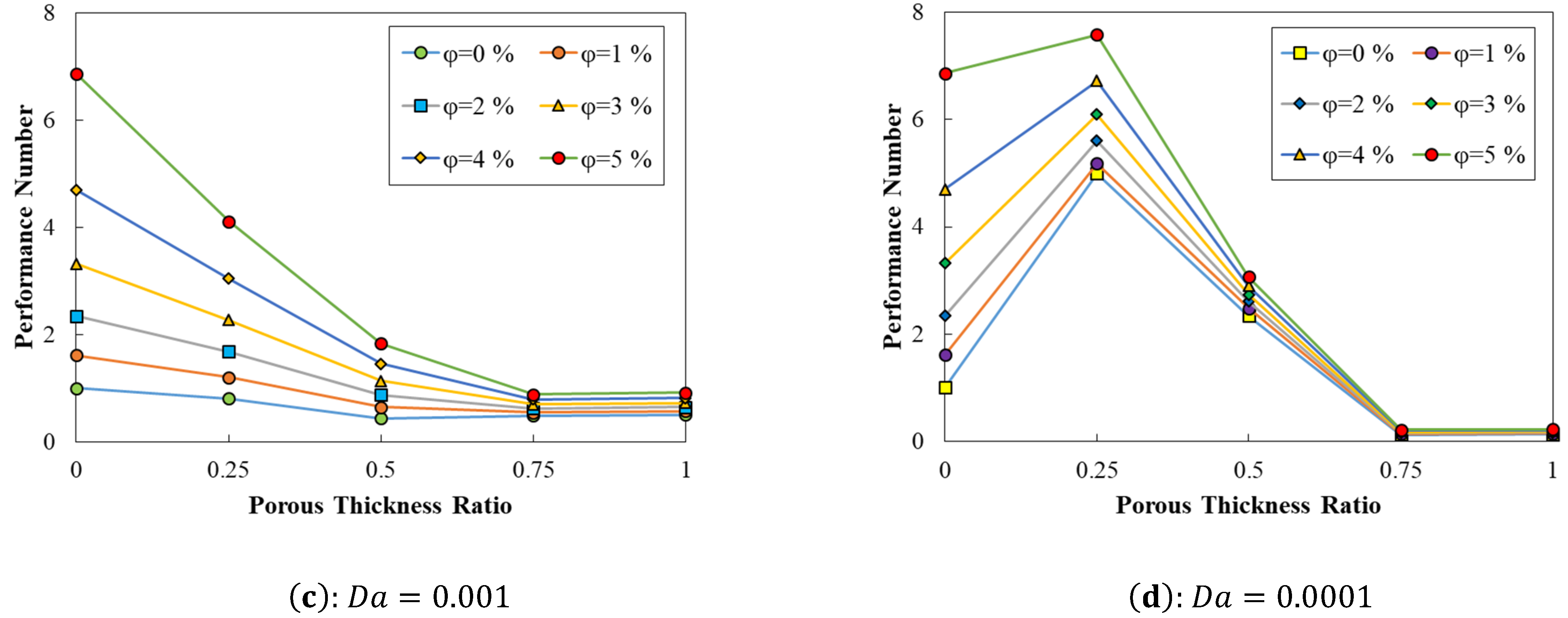
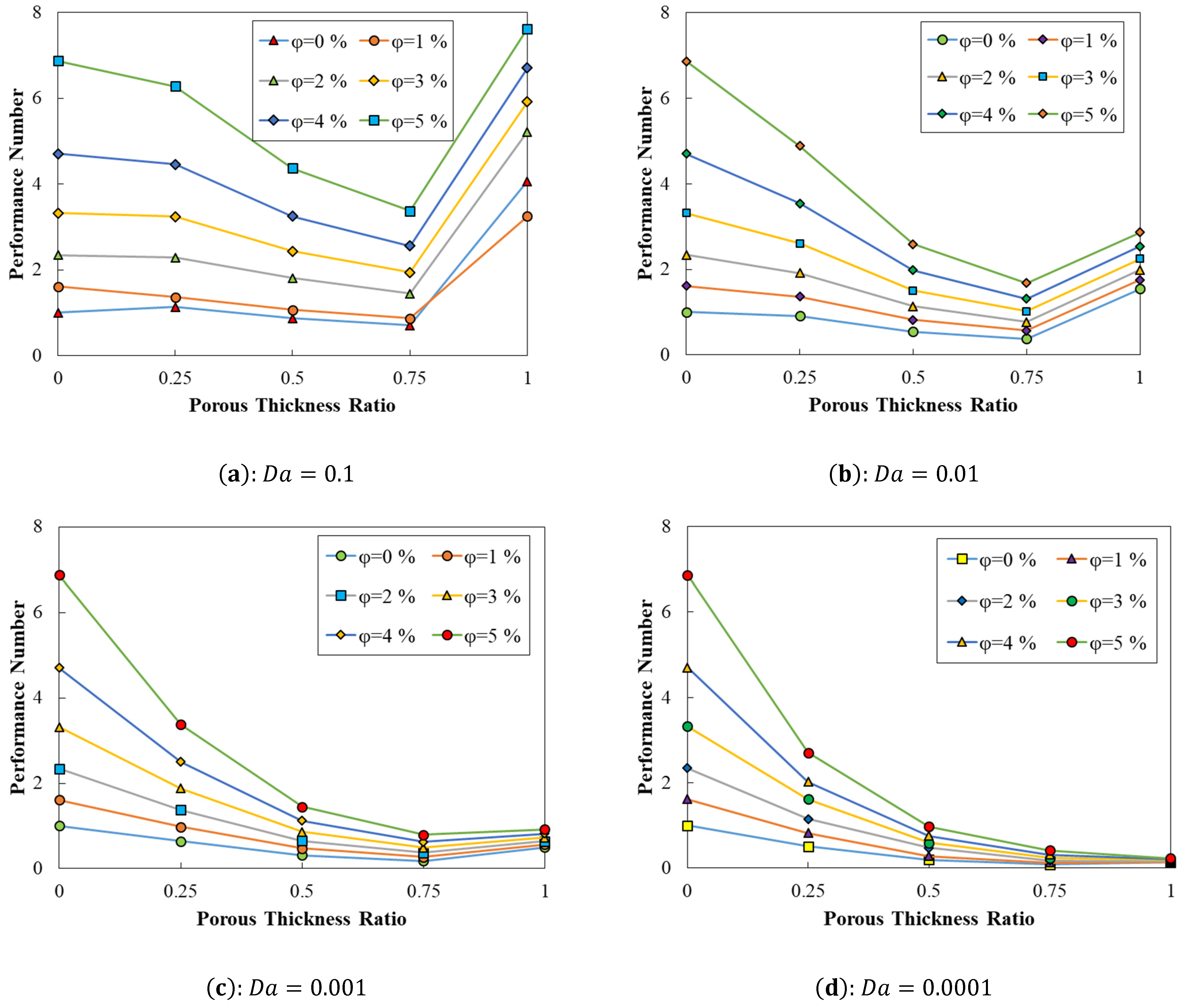
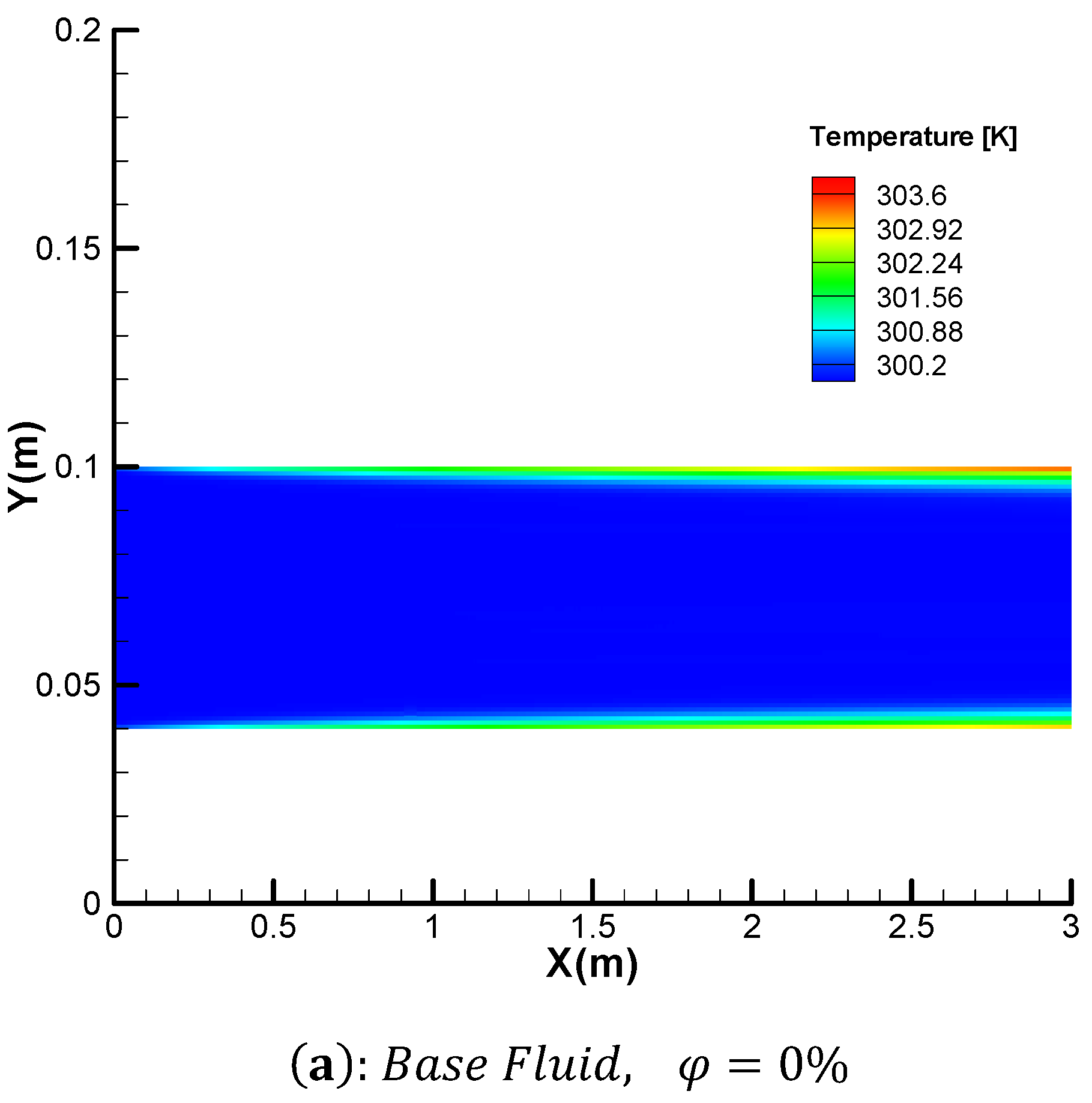
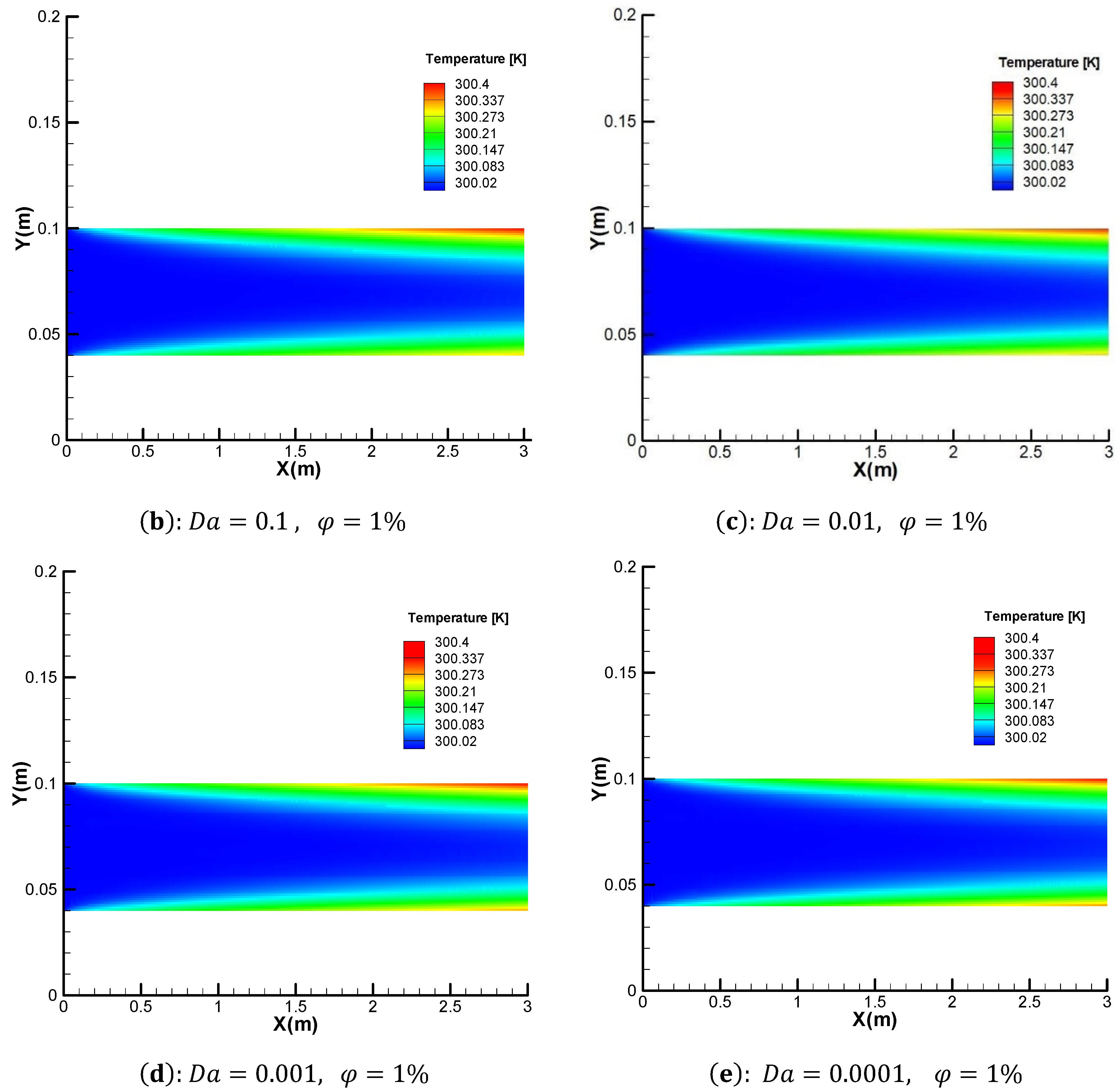
| 0 | 0.613 | 0.145 | 0.542 |
| 1 | 0.616 | 0.142 | 0.537 |
| 2 | 0.652 | 0.125 | 0.558 |
| 3 | 0.764 | 0.114 | 0.571 |
| 4 | 0.826 | 0.110 | 0.586 |
| 5 | 0.9036 | 0.103 | 0.594 |
| 4179 | 765 | 540 | ||
| 0.613 | 40 | 18 | ||
| 997 | 3970 | 6500 | ||
| 0.000998 | - | - |
| Mesh Size | Nusselt Number |
|---|---|
| 17.6 | |
| 30.6 | |
| 38.6 | |
| 40.5 | |
| 40.6 |
Publisher’s Note: MDPI stays neutral with regard to jurisdictional claims in published maps and institutional affiliations. |
© 2022 by the authors. Licensee MDPI, Basel, Switzerland. This article is an open access article distributed under the terms and conditions of the Creative Commons Attribution (CC BY) license (https://creativecommons.org/licenses/by/4.0/).
Share and Cite
Moghadasi, H.; Bayat, M.; Aminian, E.; Hattel, J.H.; Bodaghi, M. A Computational Fluid Dynamics Study of Laminar Forced Convection Improvement of a Non-Newtonian Hybrid Nanofluid within an Annular Pipe in Porous Media. Energies 2022, 15, 8207. https://doi.org/10.3390/en15218207
Moghadasi H, Bayat M, Aminian E, Hattel JH, Bodaghi M. A Computational Fluid Dynamics Study of Laminar Forced Convection Improvement of a Non-Newtonian Hybrid Nanofluid within an Annular Pipe in Porous Media. Energies. 2022; 15(21):8207. https://doi.org/10.3390/en15218207
Chicago/Turabian StyleMoghadasi, Hesam, Mohamad Bayat, Ehsan Aminian, Jesper H. Hattel, and Mahdi Bodaghi. 2022. "A Computational Fluid Dynamics Study of Laminar Forced Convection Improvement of a Non-Newtonian Hybrid Nanofluid within an Annular Pipe in Porous Media" Energies 15, no. 21: 8207. https://doi.org/10.3390/en15218207
APA StyleMoghadasi, H., Bayat, M., Aminian, E., Hattel, J. H., & Bodaghi, M. (2022). A Computational Fluid Dynamics Study of Laminar Forced Convection Improvement of a Non-Newtonian Hybrid Nanofluid within an Annular Pipe in Porous Media. Energies, 15(21), 8207. https://doi.org/10.3390/en15218207











